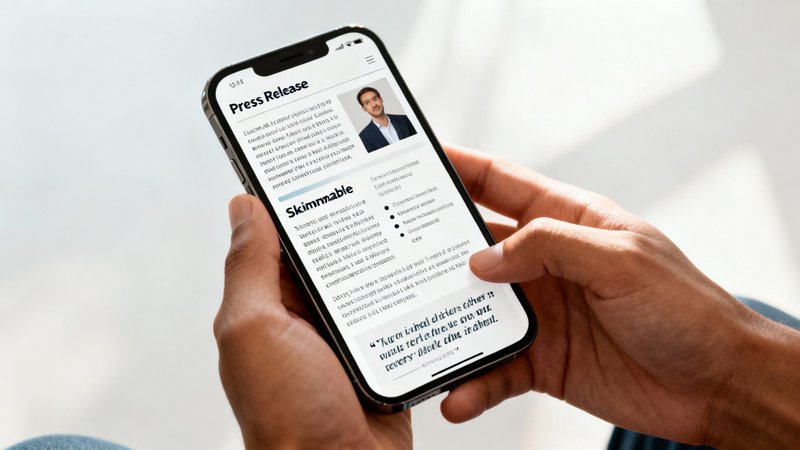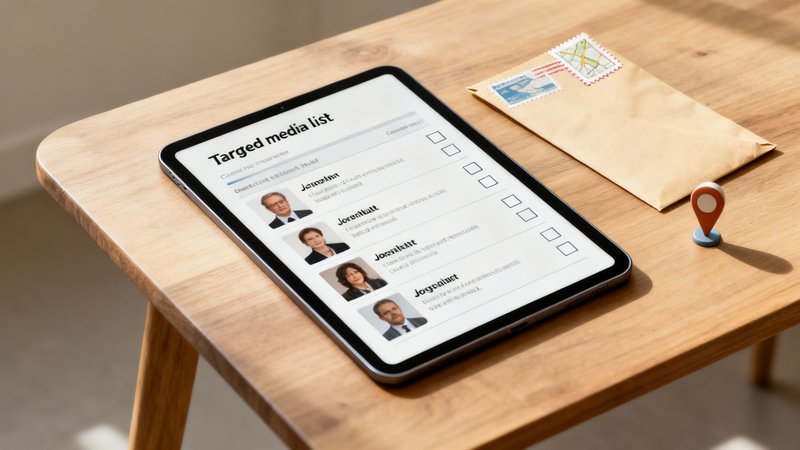
A Real Marketing Strategy for Small Business
Finally, a practical marketing strategy for small business owners in Australia. No jargon, just real-world advice to help you connect with customers and grow.
10 Nov 2025
Struggling with how to write press releases? Learn the insider strategies to craft compelling stories journalists actually want to cover. Real tips, no fluff.
Blog
Writing a good press release comes down to one simple thing: telling a compelling, newsworthy story and getting it to the right person. The secret? You need to stop thinking like a marketer and start thinking like a journalist.
The idea of writing a press release probably fills you with a special kind of dread. It feels like a massive chore. A chore with a tiny, tiny chance of a payoff.
You've got important news. Something you're genuinely proud of. But the fear, the nagging voice in your head, is that it will just vanish into a journalist’s overflowing inbox. Another casualty among hundreds of unread emails. We’ve all been there. I know I have. You pour your heart and soul into it, you hit send, and then… crickets.
It's an incredibly frustrating feeling. And it happens because, honestly, we’ve been taught to think about press releases all wrong.
We see them as these stuffy, formal corporate announcements that have to be stuffed with buzzwords and self-congratulatory quotes. But that's not what they are. A great press release is simply a good story sent to a very, very busy person. That's it. It’s a conversation starter.
This guide is all about making that mental shift. We're going to break down why the old, dry approach consistently fails and how reframing your news as a 'story' instead of an 'announcement' changes absolutely everything. It’s like switching from black and white to colour.
This isn't just a fluffy concept. It's a practical change that respects a journalist's time and immediately answers their first, most critical question: "Why should my readers care?"
A boring announcement talks about what you did. A compelling story explains why it matters to someone else. That single change in perspective is the difference between being ignored and getting published.
You might be wondering if it's even worth the effort anymore. I get it. Despite the chatter, press releases are far from dead, especially here in Australia. They're still an incredibly powerful tool… if you know how to use them properly.
Don't just take my word for it. The data shows journalists are actively relying on them. They’re actually looking for them.
In fact, a massive 83% of Australian journalists use press releases as a source for their stories, a figure that's held steady for the last few years. And the vast majority, a whopping 88%, get them sent directly via email from PR contacts. That’s huge. You can dive into the full Australian Media Landscape Report from Medianet to see just how vital this direct line of communication is.
This tells us two crucial things:
So, the problem isn't the press release itself. The problem is the way most of them are written. They’re created without a story, without a hook, and without a single thought for the person on the receiving end.
Let’s change that.
Alright, let's get into the nuts and bolts. But please, don't let the word 'format' make your eyes glaze over. This isn't about rigid, soul-crushing rules. Not at all.
Think of it like a recipe for your favourite meal. You need all the right ingredients in the right order for it to work. Simple. But the real magic, the flavour… that comes from how you combine them with a bit of personality. We’re going to walk through each essential part of a press release, one by one.
This structure isn't just for show. It’s a roadmap for a busy journalist. You’re making their job easier by giving them the information exactly where they expect to find it. Get this right, and you've already won half the battle. Seriously.
To make this super clear, here’s a quick rundown of the essential parts of a press release. Think of this as your cheat sheet. These are the building blocks.
Once you know these components, you can assemble them quickly and confidently every single time. It's about building a solid frame that lets your story really shine.
I can't stress this enough. If your headline and first paragraph don't grab a journalist in about 15 seconds, you're done. Gone. They’ll hit delete and move on to the next one without a second thought. It's brutal out there, but it's the reality of their day.
Your headline shouldn't be clever or mysterious. It needs to be a spoiler. It should give away the most newsworthy part of your story instantly.
Bad Headline: Local Tech Company Announces Exciting New Initiative
Good Headline: Sydney Startup ‘InnovateAI’ Secures $5M to Combat Food Waste with AI
See the difference? The first one is vague and full of corporate fluff. It means nothing. The second one tells you who, what, and why it matters. It’s packed with searchable keywords and real, tangible information. A journalist can actually use that.
Then comes the lead paragraph. This is where you quickly summarise the entire story using the classic inverted pyramid style. The most critical information goes right at the top. Everything else is just supporting detail. I learned this the hard way after sending out a release for a product launch where the actual product wasn't mentioned until the third paragraph. The response? Crickets. It was a painful, but valuable, lesson in clarity.
Now, let's talk about the boilerplate. This little paragraph at the end seems like an afterthought, but it’s your chance to control your company’s narrative. It’s the one part of the press release you can use over and over again. Your consistent sign-off to the world.
It's not a sales pitch. It’s a factual, concise summary of who you are.
A good boilerplate should:
Think of it as your company’s professional signature. It gives a journalist instant context without them having to go searching for it. Getting this right takes a certain skill, and if writing isn't your strong suit, it's worth exploring the importance of professional copywriting to ensure your key messages are sharp and effective.
Your goal is simple: make a journalist's life easier. Give them everything they need, packaged neatly, and you’ll find your stories get picked up far more often. It’s all about respect for their time and their process.
Let me tell you a story. It’s a bit painful, but it’s a lesson I learned the hard way.
Years ago, I spent days, maybe even a whole week, perfecting a press release for a minor software update. In my mind, it was groundbreaking. World-changing stuff. I was absolutely convinced journalists would be banging down my door. I hit send, sat back, and waited for the flood of enquiries.
The response? Deafening silence. Nothing.
That humbling experience taught me the single most important rule of PR: Just because something is a huge deal to you, it doesn't automatically make it newsworthy to the rest of the world. Ouch.
It forced me to stop thinking like a proud founder and start thinking like a cynical journalist. This section is all about helping you avoid my painful silence. We're going to dig into what actually makes a story compelling enough for someone else to bother writing about it.
Journalists aren't in the business of announcements; they're hunting for stories. Their entire job, their whole career, is to find things that will capture the attention of their audience. Day in and day out, they’re asking themselves one simple question: “So what?”
If you can’t answer that question clearly and immediately, your press release is destined for the bin.
To find your angle, you have to connect your news to a much bigger picture. It’s about finding that thread that links your "thing" to something people are already talking about, worrying about, or interested in. This is where you need to get a bit creative. And to consistently unearth compelling narratives, learning proven techniques to boost creativity is a non-negotiable skill for any modern marketer.
Here are a few classic news hooks that journalists are always on the lookout for:
Okay, let’s get practical. Your announcement might seem straightforward on the surface, but there’s almost always a more interesting story hiding underneath. Your job is to dig it out. Be a detective.
Let's brainstorm a couple of common scenarios.
Scenario 1: You’re launching a new eco-friendly coffee cup.
See the difference? We connected a simple product launch to a massive, well-known environmental issue. We added a location to make it instantly relevant to local media, and we used a powerful statistic to show the scale of the impact. Suddenly, it’s not just a cup. It’s a story about Aussie innovation and sustainability. This is exactly where understanding why storytelling is so important to your marketing can completely transform your results.
Scenario 2: You just hired a new senior manager.
Instead of a dry staff announcement, this becomes a story about local economic growth. It taps into the trend of professionals moving away from big cities and positions your company as a key player in the local business scene. This is a story a local newspaper or business journal might actually run with.
Before you write a single word of your press release, you must be able to finish this sentence in a way that would interest a complete stranger: "This matters because..."
If your answer is "it matters because it will make us more money," you haven't found your angle yet. Keep digging. The real story is never just about you; it's about the impact your news has on others.
Let's be brutally honest for a moment. Journalists, editors, and producers are not settling in with a cup of tea to read your press release like it's a gripping novel.
It just doesn't happen. They're busy. They're overwhelmed. They scan.

In just a few seconds, they’re hunting for the key information, a compelling quote, and a reason to care. If they can't find it instantly, they'll move on without a second thought. It's not personal... it's pure survival in an overflowing inbox.
So, how do you write for them? You make your press release incredibly easy to digest. You create a frictionless reading experience that guides their eyes straight to the good stuff.
The single biggest mistake I see is dense walls of text. It's visually intimidating and an instant turn-off for a scanner. An absolute nightmare.
The solution is simple. Break. It. Up.
Seriously, keep your paragraphs short. Really short. One to three sentences is the golden rule here. This creates white space around your words, making the entire document feel more approachable and less like a university textbook. It lets the content breathe.
Think of each paragraph as a single, complete thought. Make your point, then hit enter. This simple change forces you to be concise and makes your key messages pop right off the page.
Your reader is looking for specific information. Subheadings act like signposts on a highway, telling them exactly what's coming next and allowing them to jump straight to the sections that matter most to them.
Don't try to be clever. Your subheadings should be clear and descriptive.
Using clear signposts like this shows you respect the journalist's time. You’re not making them work to find the information; you're serving it up on a platter. It’s a small detail that makes a huge difference.
When you make information easy to find, you make the story easy to write. Your goal is to do as much of the journalist's work for them as you possibly can.
What are the most important, attention-grabbing pieces of information in your announcement? Are there shocking statistics, important dates, or impressive figures? Don't bury them in a paragraph. That's where good facts go to die.
Pull them out. Put them in a bulleted list.
This formatting trick is like shining a spotlight on your most compelling facts. For example, instead of a long sentence, try this:
This is especially crucial because you're competing for attention in a very crowded space. With Australians now spending nearly five hours a day consuming news online, your press release must be optimised for digital skimming. It has to be.
Major news sites like ABC News and News.com.au pull in over 12 million visitors a month, and the only way your story gets there is if it’s easy for a journalist to grab the key facts quickly. You can read more about Australian online news consumption habits to understand just how important scannable content is.
By formatting your press release for scanners, you're not dumbing it down. You're making it smarter. You’re making it more effective. And you're making it significantly more likely to get picked up.
You could write the world's greatest press release. A true masterpiece. A work of art. But if you send it to the wrong people, or in the wrong way… it's like shouting into the wind. It never existed.

I've seen it happen so many times. A brilliant story, full of potential, gets blasted out to a generic, purchased media list and dies a quiet death in thousands of irrelevant inboxes. It’s heartbreaking. Truly.
Your distribution plan is every bit as critical as your writing. This is about getting your story into the right hands... the ones that actually matter.
The biggest mistake you can make is the "spray and pray" approach. It just doesn't work. Journalists can spot a generic email blast from a kilometre away, and it's a one-way ticket to their spam folder.
Instead, you need to build a small, targeted, and meticulously researched media list. Think of it as crafting a guest list for an exclusive dinner party, not flyering an entire suburb.
Your list should be a living document that includes:
A list of 10 perfect contacts who you've personally researched is a thousand times more valuable than a list of 1,000 random email addresses. Quality over quantity isn't just a cliché here; it's the entire strategy.
Building this takes time. I won't lie to you. There are no shortcuts. But this targeted approach shows respect, and in the world of media relations, respect is everything.
Now you have your list, it's time to craft the pitch. Remember, you're not just attaching the press release; you're writing a personal note to another human being. A busy human being.
Your email needs to be incredibly brief. It has one job: to convince them to open the document.
The Subject Line is Your Headline
It has to be compelling and clear. Don't be vague. A great subject line often mirrors your press release headline.
The Body is Your Hook
The email itself should only be two or three sentences long. Seriously. That's all.
Start by showing you've done your homework. "Hi [Journalist's Name], I saw your recent piece on sustainable hospitality and thought this might be a good fit for your readers."
Then, deliver the hook. "We've just launched a new platform that's helping local cafes reduce food waste by up to 30%, and I've attached a press release with all the details."
That's it. It’s personal, relevant, and gets straight to the point. For a deeper dive into making these connections, listening to experts discuss how to use PR to grow your business is incredibly insightful.
What about distribution services, or "the wire"? These platforms send your release out to a massive network of newsrooms. They have their place, but for small businesses, they are often a waste of money. Just being honest.
A wire service is useful if you have major corporate news that needs to be distributed widely for compliance reasons... think stock market announcements or huge mergers.
But for a product launch or a local story? Your personal, targeted pitching will almost always deliver better results. It’s about building relationships, not just broadcasting a message.
To truly maximise your press release's impact, integrate it into a comprehensive social media strategy, drawing on these social media marketing best practices. This is especially true in Australia's highly digital and mobile-centric media landscape, where a smart, respectful, and targeted approach is the only way to succeed.
Alright, let’s wrap this up by tackling some of those nagging questions. You know the ones... the little details that pop into your head right before you hit ‘send’, making you second-guess everything you’ve just written.
It’s completely normal. You've poured all this effort into finding your story and crafting it perfectly, so you want to make sure you don't stumble at the final hurdle. Let's clear up that confusion.
These are the things people often wonder but don't always ask.
This is a big one. I’ve seen people write epic, multi-page documents, thinking that more detail equals more value. But for a time-poor journalist, the opposite is true.
Keep it concise. Short and sweet. The sweet spot is generally between 400 and 500 words. That’s about one single A4 page.
A shorter, punchier release that gets straight to the point is always more effective than a long, rambling one. Your job is to deliver the key information clearly and quickly, not to write a novel. If they need more info, they’ll ask for it.
Think of it like a movie trailer. Your press release should give them the most exciting parts and make them want to see the full movie... not spoil every single plot point.
A thousand times, yes! In fact, I’d say it's almost non-negotiable these days. You really have to.
Including high-quality multimedia like photos, infographics, or a short video can dramatically increase your chances of getting noticed. It gives journalists ready-to-use assets, which makes their job infinitely easier. If they can grab a great photo directly from your email or media kit, they are much more likely to cover your story.
Just be sure you don’t clog up their inbox in the process.
This simple act of organisation shows professionalism and respect for their time.
Ah, the million-dollar question. While there's no single magic answer that works for every industry and every journalist, there are some generally accepted best practices that can give you an edge.
Think about a typical work week. Mondays are for catching up after the weekend, and Fridays are often when people are winding down or trying to leave early. No one wants your big news at 4pm on a Friday.
That leaves a sweet spot in the middle. Mid-week, specifically Tuesday through Thursday mornings between 9 am and 11 am local time, often yields the best results. This is when journalists are typically at their desks, planning their stories for the day and actively looking for fresh content. It’s when they are most receptive to a good pitch.
Following up is a delicate dance. It really is. You want to be persistent, but you definitely don’t want to become that annoying person who clogs up their inbox. I’ve been on the receiving end, and it’s not a good look.
First, give it a few days. Don't follow up the same afternoon. Let your initial email breathe.
If you haven’t heard back in two or three business days, a single, polite follow-up email is perfectly acceptable. Keep it incredibly brief. You could offer a slightly new angle or simply ask if they need any more information to help with their story.
Never, ever follow up multiple times or call them on the phone unless you have a pre-existing relationship. The goal is to build a bridge, not burn it down. Respecting their time is the most important part of building a long-term media relationship.
Feeling overwhelmed by the thought of writing press releases and building a media strategy? You're not alone. Cemoh connects you with the top 1% of pre-vetted marketing experts who can handle everything from crafting the perfect story to getting it in front of the right journalists. Find the flexible, expert talent you need to get noticed.
Here are some suggested articles that are closely related to this post

Finally, a practical marketing strategy for small business owners in Australia. No jargon, just real-world advice to help you connect with customers and grow.

What is digital marketing consulting and how does it work? We explain what a consultant does, why you need one, and how to hire the right partner in Australia.

Feeling lost in the Australian job market? This guide has real, practical steps on how to get a job, from fixing your resume to nailing the interview.

Build a small business marketing strategy that works. This guide offers practical, no-nonsense tips for real results, designed for Australian business owners.

Need a marketing consultant for small business? Discover expert tips and guidance to boost your small business marketing success today.

Learn what is growth marketing with our practical guide to mindset, strategies, and experiments that drive real, sustainable business growth.